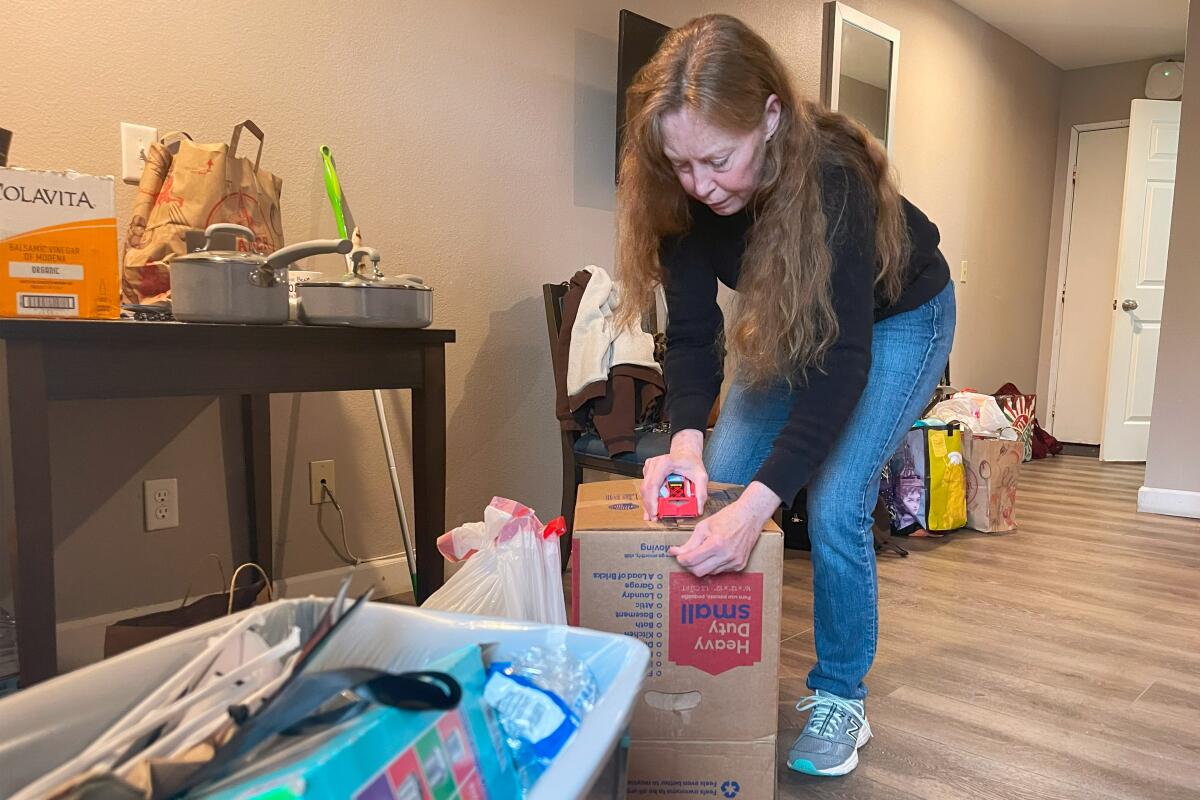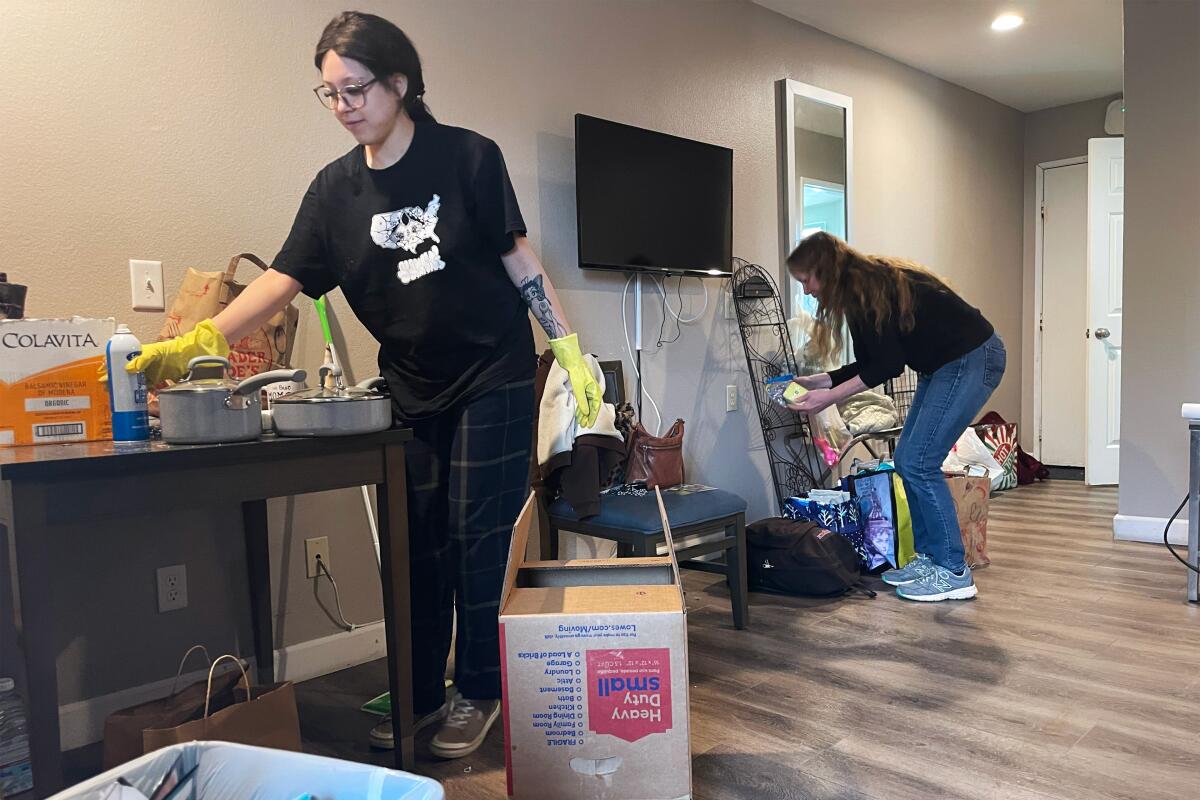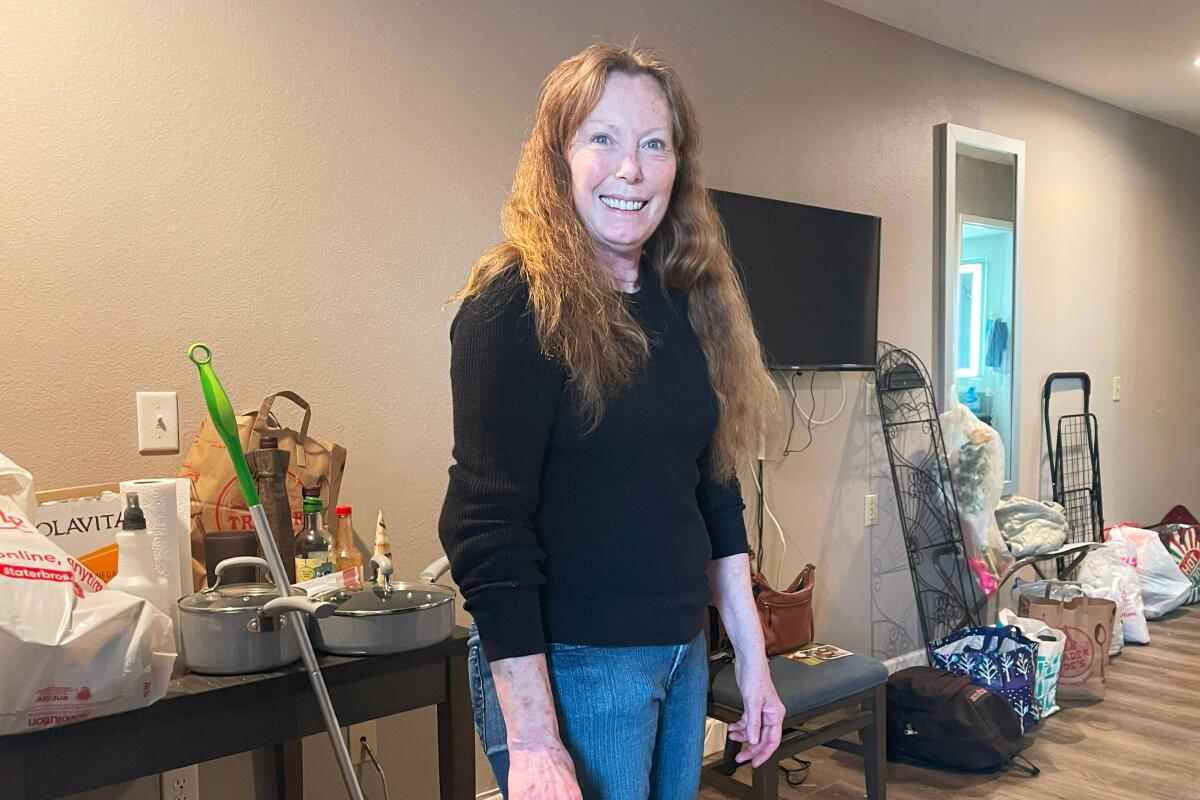On the brink of homelessness, she won the Medi-Cal lottery

- Share via
Annie Malloy started getting sick in 2020. Fits of uncontrolled vomiting would hit, causing debilitating nausea and severe dehydration that would send her to the emergency room. She couldn’t keep weight on, and the vomiting got so bad she was admitted to the hospital 26 times that year.
Malloy, one of the 15.8 million low-income people enrolled in California’s Medicaid program called Medi-Cal, racked up extraordinary healthcare costs while her doctors struggled to diagnose her illness. One hospitalization for a patient in a Medi-Cal managed-care program can cost nearly $18,000, on average.
And as she was struggling to understand the cause of her illness, without stable housing, Malloy’s health deteriorated further. The resident of Fallbrook, a community in San Diego County, was couch surfing and living in a dilapidated residential motel, unable to find an apartment on her $1,850-a-month in Social Security Disability Insurance income.
“I was absolutely on the verge of being homeless.”
But then Malloy got lucky.

In March, she became one of the first Californians to receive help covering her rental move-in costs from Medi-Cal. She still had to find something she could afford, but she was eligible for this nontraditional health service under an initiative called CalAIM. Spearheaded by Democratic Gov. Gavin Newsom, it will pour $12 billion into a range of new social services and benefits to aid some of the state’s most vulnerable enrollees, including those experiencing or at risk of homelessness.
Newsom and top state health officials say offering services such as housing assistance and healthful food will help keep people from falling into costly institutions, such as emergency rooms.
Though the Medi-Cal experiment will be tested by California’s unprecedented homelessness crisis, it has worked for Malloy.
Malloy received $5,000 to cover her housing security deposit and was linked to a medical social worker who helped her get into an apartment she could afford. And in early spring, she moved out of a roach-infested motel in Escondido to a new home in the nearby community of Fallbrook.
“I couldn’t have gotten this place without that help,” Malloy, 60, said in March as she packed dishes and scrubbed her motel room in anticipation of her move. “When you don’t have housing, everything turns into a cascade effect. You can’t manage everything and stay healthy.”

Malloy had a career as a paralegal until the uncontrolled vomiting began in early 2020 and she could no longer work. She still has a hard time affording the $1,500 rent for her one-bedroom apartment, but her granddaughter MaryJane Lindsay, who lives with her, helps cover the bills with her restaurant job. The new Medi-Cal services don’t yet pay for rent, but Newsom is proposing an expansion to cover up to six months of payments — benefits that could go far in helping other low-income Californians who need help landing housing.
“There’s so many people on the streets. It’s just impossible to help everyone who needs it,” said Ytzayana Camorlinga, a housing caseworker at the San Diego nonprofit Social Advocates for Youth, which helped Malloy land an apartment. “We were thrilled to get Annie into the program because it was the first time we did it.”
CalAIM has so far served only a sliver of Medi-Cal patients in need since it launched in January 2022 — even as tens of thousands of low-income Californians probably qualify. In San Diego County, just 20 Medi-Cal patients have received the housing move-in assistance, according to the state Department of Health Care Services, which administers Medi-Cal.
Malloy found help via her former Medi-Cal insurer, Blue Shield of California, which deemed her eligible to receive $5,000 for a security deposit.
Whether a patient is enrolled in new benefits and services depends largely on which Medi-Cal insurer they have and where they live. The community-based organizations that contract with insurers to deliver services have their own eligibility criteria, KFF Health News has found, making the system uneven. The 23 health insurers serving Medi-Cal patients have wide discretion to decide the array of CalAIM services they offer.
In San Diego, for example, some Medi-Cal patients readily get rental help, while others qualify for housing assistance only if they have a child under 18 years old. Some insurers pay for Uber rides for patients in need of medical transportation, while others offer bus passes.
“Annie was one of the first to get housing deposits, and now we know what it takes,” said Kitty Bailey, chief executive of the San Diego Wellness Collaborative, which contracts with Blue Shield and, along with Camorlinga, helped enroll Malloy into the new benefits. “This is really a fundamental shift in healthcare, and we’re trying our best to help as many people in need as we can, but it’s challenging.”
For Malloy, whose doctors are still trying to find the cause of her illness after repeated tests, it took a team of social workers and case managers acting on her behalf to help her get into housing. But now, she says, she is getting healthier.
Since moving out of the motel, Malloy says, her vomiting has been more controlled. She hasn’t had to go to the emergency room as often, she’s put on weight, and she’s on a steady prescription of potassium. Most mornings, she wakes for coffee on her back patio, a serene habit that has also improved her mental health.
Malloy recently switched health insurers and is now enrolled in Health Net because it covers more of her medical care at no cost. But the new Medi-Cal services Blue Shield helped her obtain were lifesaving, she said.
“We were in an old, beat-up hotel in a bad part of town before, and now I live in a house with a bright sunny yard surrounded by an orange grove — it’s night and day. I spend a lot of time outside, and I could not do that where I was living before,” she said. “Housing is such an important part of being healthy.”
Hart works for KFF Health News.
More to Read
Sign up for Essential California
The most important California stories and recommendations in your inbox every morning.
You may occasionally receive promotional content from the Los Angeles Times.













